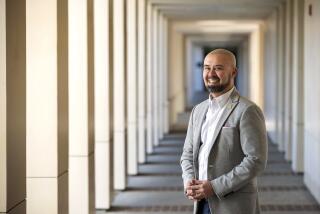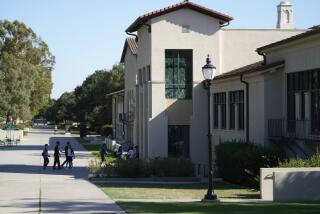Occidental’s Plan for the Future Focuses on L.A. Ties, Minorities
A comprehensive plan to guide Occidental College into the next century by encouraging diversity and broadening campus ties to the city of Los Angeles will be considered this weekend by the school’s trustees.
The plan, summarized in a nearly 60-page report, resulted from an 18-month effort called “Occidental Tomorrow” that involved more than 200 administrators, teachers, students and alumni at the liberal arts college in Eagle Rock.
It also bears the stamp of Occidental President John Slaughter, who since 1988 has tried to transform the school from a fairly homogeneous, suburban campus into one that is culturally diverse and more associated with urban Los Angeles.
Although school officials declined to discuss specifics of the plan, they said it will include ideas for attracting more minority students and teachers, and changing the curriculum and class offerings to better address the needs of different cultures. Other recommendations include such ideas as building a new student union, sending students into Los Angeles communities as volunteers and looking for ways to solve the school’s burgeoning financial aid problem.
“Not so many years ago, we were seeing ourselves as a suburban liberal arts college, and not so much a part of the city,” said David Axeen, dean of the faculty, who helped develop the plan. “We’ve become interested in seeing the institution more explicitly rooted in Los Angeles.”
Faculty members last week voted to endorse the report, which is titled “Of Excellence and Equity.” Occidental’s 35 trustees will consider it during a three-day retreat, beginning today in Rancho Santa Fe, north of San Diego.
If they approve the plan, it will be presented to students for review, school officials said.
Although not considered radical, the report’s recommendations are viewed as a “breath of fresh air” for 103-year-old Occidental. The previous long-term plan for the school was developed in 1962, Axeen said.
“There is no major sharp turn in the road that we’ve taken,” he said. “It’s one of those things where an accumulation of small changes over the years makes it necessary to look at this and put it into words.”
Slaughter could not be reached for comment. Axeen and others declined to discuss details of the report until after it is reviewed by trustees.
Axeen said the plan will seek to reduce the percentage of Occidental’s budget that now goes to financial aid. More than 65% of Occidental’s students receive such aid, which accounts for about 25% of the college’s nearly $38-million budget. School officials would like to reduce that percentage to about 20% by finding new sources of money for students, he said.
But the plan’s main agenda is increasing the school’s cultural diversity and branching out from its Eagle Rock enclave, he said.
Slaughter, who in 1988 succeeded Richard Gilman as president, pledged to address both issues, said some teachers and students involved in the planning process.
Occidental “had an ivory tower mentality . . . in terms of a very white student body, in terms of being very conservative,” said Jeff Coons, student body president. “Dr. Slaughter was the breath of fresh air students were waiting for.”
Thomas Somerville, a music instructor who helped develop the plan, said for it to succeed the college must do more than simply recruit more minority students. Instead, it must result in a campus that encourages acceptance of minorities and their cultures.
“We all have to learn how to exist together. That’s the heart of what we mean by multiculturalism at Occidental,” he said.
The strategic planning process was initiated by Slaughter soon after he took office, Somerville said. A 20-member steering committee spent months listening to consultants and developing a broad agenda.
Then about 200 people from the Los Angeles community and the school’s administration, student body, faculty and alumni formed 10 subcommittees to examine such issues as athletics, curriculum, student life, enrollment, development and alumni and community relations, he said.
Those groups made recommendations to the steering committee, which met last June to begin writing the report.
“The process is frightening and exciting,” Somerville said. “It’s taking us into the 20th Century, at least we know that. That’s better than going backward into the 19th Century.”
More to Read
Sign up for Essential California
The most important California stories and recommendations in your inbox every morning.
You may occasionally receive promotional content from the Los Angeles Times.










